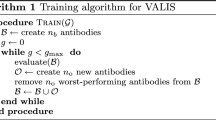Abstract
Learning classifier systems (LCSs) are a machine learning technique, which combine reinforcement learning and evolutionary algorithms to evolve a set of classifiers (or rules) for pattern classification tasks. Despite promising performance across a variety of data sets, the performance of LCS is often degraded when data sets of high dimensionality and relatively few instances are encountered, a common occurrence with gene expression data. In this paper, we propose a number of extensions to XCS, a widely used accuracy-based LCS, to tackle such problems. Our model, CoXCS, is a coevolutionary multi-population XCS. Isolated sub-populations evolve a set of classifiers based on a partitioning of the feature space in the data. Modifications to the base XCS framework are introduced including an algorithm to create the match set and a specialized crossover operator. Experimental results show that the accuracy of the proposed model is significantly better than other well-known classifiers when the ratio of data features to samples is extremely large.
Preview
Unable to display preview. Download preview PDF.
Similar content being viewed by others
References
UCI Machine Learning Repository, http://archive.ics.uci.edu/ml/
Bull, L., Kovacs, T. (eds.): Foundations of Learning Classifier Systems. Studies in Fuzziness and Soft Computing, vol. 183. Springer, Heidelberg (2005)
Butz, M., Pelikan, M., Lloral, X., Goldberg, D.E.: Automated global structure extraction for effective local building block processing in XCS. Evolutionary Computation 14(3), 345–380 (2006)
Butz, M.V., Kovacs, T., Lanzi, P.L., Wilson, S.W.: Toward a theory of generalization and learning in XCS. IEEE Transactions on Evolutionary Computation 8(1), 28–46 (2004)
Butz, M.V., Wilson, S.W.: An Algorithmic Description of XCS. In: Lanzi, P.L., Stolzmann, W., Wilson, S.W. (eds.) IWLCS 2000. LNCS (LNAI), vol. 1996, pp. 253–274. Springer, Heidelberg (2001)
Dam, H.H., Abbass, H.A., Lokan, C.: DXCS: an XCS system for distributed data mining. In: Proceedings of the 2005 conference on Genetic and evolutionary computation (GECCO 2005), pp. 1883–1890. ACM Press, New York (2005)
Gershoff, M., Schulenburg, S.: Collective behavior based hierarchical XCS. In: Proceedings of the 2007 Genetic And Evolutionary Computation Conference (GECCO 2007), pp. 2695–2700. ACM Press, New York (2007)
Goldberg, D.E.: Genetic Algorithms in Search, Optimization, and Machine Learning. Addison-Wesley, Reading (1989)
Hanley, J.A., McNeil, B.J.: The meaning and use of the area under a receiver operating characteristic (ROC) curve. Radiology 143(1), 29–36 (1982)
Hedenfalk, I., Duggan, D., Chen, Y., Radmacher, M., Bittner, M., Simon, R., Meltzer, P., Gusterson, B., Esteller, M., Kallioniemi, O.P., Wilfond, B., Borg, A., Trent, J.: Gene-Expression profiles in hereditary breast cancer. N. Engl. J. Med. 344(8), 539–548 (2001)
Holland, J.H., Booker, L.B., Colombetti, M., Dorigo, M., Goldberg, D.E., Forrest, S., Riolo, R.L., Smith, R.E., Lanzi, P.L., Stolzmann, W., Wilson, S.W.: What is a Learning Classifier System? In: Lanzi, P.L., Stolzmann, W., Wilson, S.W. (eds.) IWLCS 1999. LNCS (LNAI), vol. 1813, pp. 3–32. Springer, Heidelberg (2000)
Hossain, M.M., Hassan, M.R., Bailey, J.: ROC-tree: A Novel Decision Tree Induction Algorithm Based on Receiver Operating Characteristics to Classify Gene Expression Data. In: Proceedings of the SIAM International Conference on Data Mining, Atlanta, Georgia, USA, April 2008, pp. 455–465 (2008)
Kovacs, T.: Two views of classifier systems. In: Lanzi, P.L., Stolzmann, W., Wilson, S.W. (eds.) IWLCS 2001. LNCS (LNAI), vol. 2321, pp. 74–87. Springer, Heidelberg (2002)
Lanzi, P.L.: A Study of the Generalization Capabilities of XCS. In: Bäck, T. (ed.) Proceedings of the 7th International Conference on Genetic Algorithms, pp. 418–425. Morgan Kaufmann, San Francisco (1997)
Lanzi, P.L., Stolzmann, W., Wilson, S.W. (eds.): IWLCS 1999. LNCS (LNAI), vol. 1813. Springer, Heidelberg (2000)
Potter, M.A., Jong, K.A.D.: Cooperative Coevolution: An Architecture for Evolving Coadapted Subcomponents. Evolutionary Computation 8(1), 1–29 (2000)
Richter, U., Prothmann, H., Schmeck, H.: Improving XCS performance by distribution. In: Li, X., Kirley, M., Zhang, M., Green, D., Ciesielski, V., Abbass, H.A., Michalewicz, Z., Hendtlass, T., Deb, K., Tan, K.C., Branke, J., Shi, Y. (eds.) SEAL 2008. LNCS, vol. 5361, pp. 111–120. Springer, Heidelberg (2008)
Skinner, B., Nguyen, H., Liu, D.: Distributed classifier migration in XCS for classification of electroencephalographic signals. In: 2007 IEEE Congress on Evolutionary Computation, pp. 2829–2836. IEEE Press, Los Alamitos (2007)
Wilson, S.W.: Classifier Fitness Based on Accuracy. Evolutionary Computation 3(2), 149–175 (1995), http://prediction-dynamics.com/
Wilson, S.W.: Get Real! XCS with Continuous-Valued Inputs. In: Lanzi, P.L., Stolzmann, W., Wilson, S.W. (eds.) IWLCS 1999. LNCS (LNAI), vol. 1813, pp. 209–222. Springer, Heidelberg (2000)
Zhang, Y., Rajapakse, J.C.: Machine Learning in Bioinformatics, 1st edn. Series in Bioinformatics. Wiley, Chichester (2008)
Zhu, F., Guan, S.: Cooperative co-evolution of GA-based classifiers based on input decomposition. Engineering Applications of Artificial Intelligence 21, 1360–1369 (2008)
Author information
Authors and Affiliations
Editor information
Editors and Affiliations
Rights and permissions
Copyright information
© 2009 Springer-Verlag Berlin Heidelberg
About this paper
Cite this paper
Abedini, M., Kirley, M. (2009). CoXCS: A Coevolutionary Learning Classifier Based on Feature Space Partitioning. In: Nicholson, A., Li, X. (eds) AI 2009: Advances in Artificial Intelligence. AI 2009. Lecture Notes in Computer Science(), vol 5866. Springer, Berlin, Heidelberg. https://doi.org/10.1007/978-3-642-10439-8_37
Download citation
DOI: https://doi.org/10.1007/978-3-642-10439-8_37
Publisher Name: Springer, Berlin, Heidelberg
Print ISBN: 978-3-642-10438-1
Online ISBN: 978-3-642-10439-8
eBook Packages: Computer ScienceComputer Science (R0)




